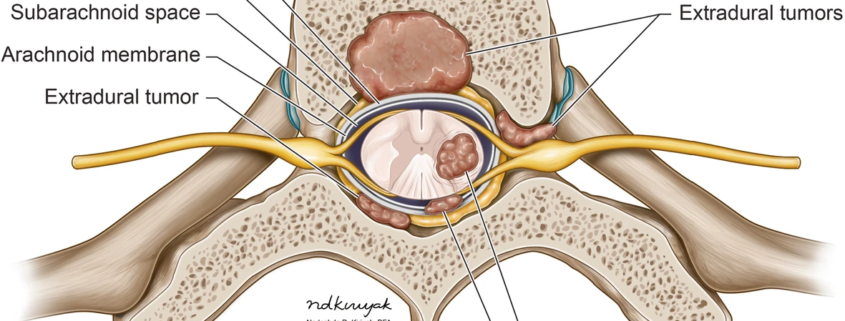Spinal Tumors

Overview
Spinal tumors are abnormal growths found on the spine. These growths can be malignant (cancerous) or benign (non-cancerous), and they can occur within the spinal cord itself, in the membranes covering the spinal cord, or in the space between the spinal cord and the vertebrae, the bones that construct the spine. It’s crucial to know that spinal tumors are a fairly uncommon condition, but they can have serious impacts on your health when they occur.
Types
There are several types of spinal tumors that are typically classified by their location. They include:
-
- Intradural-Extramedullary Tumors: These grow within the “dura” (spinal cord’s covering) but outside the nerves. Meningiomas and schwannomas are examples of this type.
-
- Intramedullary Tumors: These occur within the nerves of the spinal cord itself. Ependymomas and astrocytomas fall under this category.
-
- Extradural Tumors: These are the most common spinal tumors and grow in the bones and ligaments of the vertebrae. They usually originate from cancer in another part of the body that has spread.
Causes
The exact cause of spinal tumors isn’t well-known. However, certain risk factors increase the likelihood of developing a spinal tumor, including:
-
- Having a family history of spinal tumors
-
- Exposure to certain chemicals and radiation
-
- Certain inherited conditions such as neurofibromatosis and Von Hippel-Lindau disease
Symptoms
Many people with spinal tumors experience little to no symptoms in the early stages. However, common symptoms as the tumor progresses include:
-
- Back pain radiating to other parts of the body
-
- Loss of sensation or motor function, particularly in the lower body
-
- Dysfunction of bladder or bowel control
-
- Unexpected weight loss or fatigue
Diagnosis
Diagnosing a spinal tumor typically begins with a thorough medical history check and a physical examination by a doctor. Utilizing imaging tests such as MRI scans, CT scans, and X-rays is also common. In some cases, a biopsy may be performed to differentiate cancerous from non-cancerous spinal tumors.
Treatment Options
Treatment for spinal tumors can vary greatly depending on details like the type, size, and location of the tumor, along with the patient’s overall health. Possible treatments include:
-
- Watchful Waiting: If the tumor is not causing significant symptoms, doctors may opt to monitor it closely.
-
- Surgery: This is often attempted for removal of the entire tumor, if possible, to alleviate symptoms and improve neurological function.
-
- Radiation Therapy: This method involves using high-energy beams to kill tumor cells and is often used after surgery or for inoperable tumors.
-
- Chemotherapy: For cancerous tumors, chemotherapy drugs may be used to kill the cancer cells.
Living With Spinal Tumors
Living with a spinal tumor can have both physical and emotional effects. Practical tips for managing include:
-
- Engaging in regular physical therapy for mobility and strength
-
- Eating a balanced diet to support overall health and energy
-
- Seeking emotional support from counselors, support groups, or loved ones
-
- Staying involved in activities you enjoy to maintain a sense of normalcy
When to Seek Help
You should consult a medical professional if you experience persistent, unexplained back or neck pain, loss of sensation in your limbs, difficulty with balance or walking, or loss of bowel or bladder control. These symptoms could indicate a spinal tumor or other serious conditions. Recognizing and acting on these symptoms early will offer the best chances of successful diagnosis and treatment.
